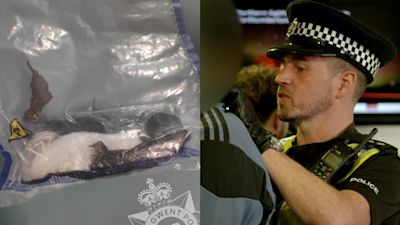Children as 'young as nine' in north Wales targeted by County Lines drug gangs

Children as young as nine are being targeted by drugs gangs and being made to carry weapons in north Wales as part of County Lines operations, ITV News has been told.
As part of an investigation into County Lines, where illegal drugs are transported from one area to another, often into rural communities, one social worker told current affairs programme Y Byd Ar Bedwar that the Covid pandemic caused an increase in referrals to support services.
Figures obtained by the programme show there are currently between ten and 15 known active County Lines in the force area.
Lois Owen works with children who have been exploited by these gangs.
“Children will go missing from home or from care. Children might be out at unusual hours - if they’re 10 years old and are out at 2am, then that can be a sign that they are being exploited by County Lines gangs", Lois Owen said. “We’ve seen a big increase since Covid, and that’s partly because the children weren’t going to school because the schools were closed - and they [schools] are the ones that would see those children five days a week.”
“Any injuries without explanation can be a sign, or if they have new items and can’t explain how.”
According to the National Crime Agency, County Lines is where illegal drugs are transported from one area to another, often across police and local authority boundaries (although not exclusively), usually by children or vulnerable people who are coerced into it by gangs.
Since the start of the year, North Wales Police said it has identified 44 individuals under the age of 18 who are linked to County Lines incidents.
Lois Owen and her team receive referrals from the police and the education and health sector. The youngest child she has worked with was nine years old. She told the programme children are often targeted via social media and "befriended" by the gangs.
“What we are seeing more and more recently is that they’re [drugs gangs] using social media and get to know the children really well.
"We call this the befriending process, and from that the child will feel that they’re friends with the people in their gang and it’s easier them for the child to do what these individuals are asking of them.”
“The gangs will expect the children to deal drugs. Or depending on age they will get the child to look after money. The youngest children will be on watch to make sure the gang doesn't get caught.”
“We also know children carry weapons and sometimes the gangs will ask the children to look after weapons for them. The youngest are the ones that don’t get stopped by different agencies.”
Lois spends time with the child in order to win their trust, but said Covid made the job more difficult.
“It was hard. Children weren't being seen.
“We’ve seen a big increase [in referrals] since Covid, and that’s partly because the children weren’t going to school because the schools were closed - and they’re the ones that would see those children 5 days a week.”
In a bid to disrupt gang activity of drug gangs, police launched a crackdown at the start of the month.
“We’re targeting the rail network", Richard Powell from British Transport Police said.
"We have a drugs dog out who is looking to indicate on people who might be in possession of controlled drugs, but the wider picture is around exploitation and trying to identify people who are potentially carrying drugs. Particularly younger people they might not want to be carrying those drugs, they might have been pulled into a world that they don’t understand."
As part of the crackdown which included three Welsh police forces, £700,000 worth of cocaine was seized, five County Lines were dismantled and 46 people were arrested.
Twenty four adults and children were also safeguarded as part of the operation.
Inspector Richard Powell said “For anyone under the age of 18 they might feel that they’re a part of a group, get a sense of belonging when in actual fact they’re being exploited.”
Y Byd ar Bedwar airs on Monday October 24 at 8.25pm. English subtitles available